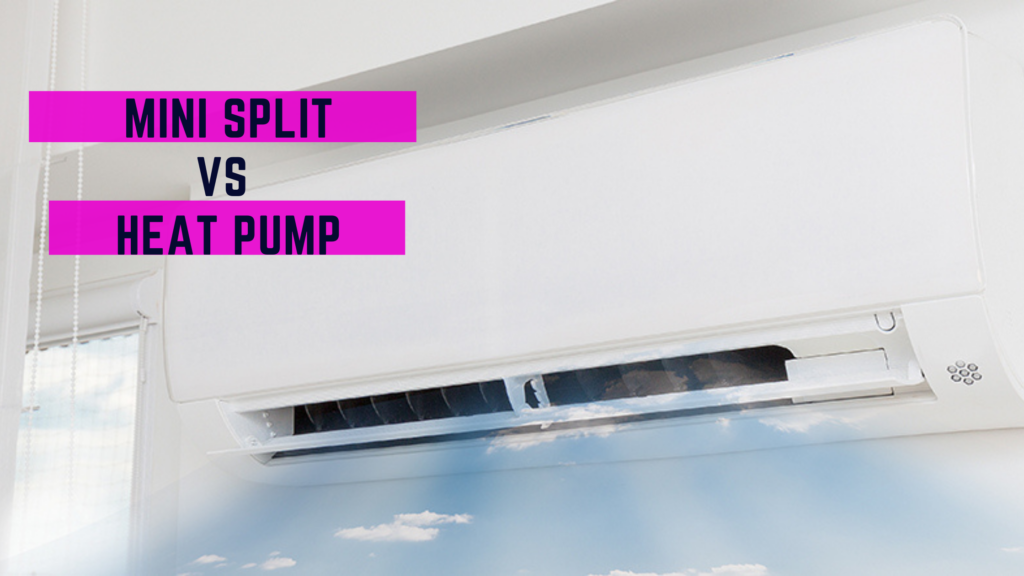Hi! In full disclosure, we may earn money from companies (like Amazon) mentioned in this post if you make a purchase through our links. Thanks in advance for the support!
Mini Split vs Heat Pump Comparison
Mini-Splits have proven to be a reliable air conditioning solution. It can cool homes fast with efficient energy use. But how does a mini-split perform when it comes to cooling and heating spaces and how does it compare to a regular heat pump?
How Heat Pumps Work Compared To A Mini-Split
A heat pump generally refers to a system that transfers heat from an outside source through a compressor and gas refrigerant. The heat extracted is then pumped indoors to get a warmer temperature. This system uses very little energy compared to those using energy to be converted into heat.
The heat can be sourced from the ground (geothermal), the air, or a water source.
Geothermal and water source heat pumps are typically used to heat water but they can also be used to heat spaces through the use of additional components. It can also be connected to radiators and underfloor heaters. Cooling is also possible with the use of reversing valves. This component shifts the direction of the refrigerant flow to reverse the air cycle from cooling to heating; heating to cooling.
With air-to-air heat pumps, the warm air can be blown from a ducted HVAC system or a ductless mini-split indoor unit.
As for heat gathered from a water source, it can be used to both heat water and indoor air. But heating spaces from a water source is not typically done.
CALL FOR QUOTE: 1.855.920.1857
Mini-split with Heat Pumps
Regular cooling AC systems use a similar process with heat pumps to get a colder indoor temperature. The heat from the area is extracted through the indoor unit and flows through the refrigerant lines. The warm air is sent to the compressor. Once it circulates to the evaporator coil, the refrigerant is cooled and a fan blows over the coil to send colder air indoors.
This is how air is processed through a mini-split system. The difference with packaged air conditioners and a mini-split system is the splits make use of three separate main components to modify room temperature. These are your indoor air handler, refrigerant lines, and outside compressor unit.
Although fairly similar in process, air conditioners cannot provide heating but heat pumps can provide both heating and cooling. There are cooling only mini-splits and there are mini-splits that can do both. What makes the difference is the reversing valve that can be found in the outdoor unit of a mini-split with heat pump system.
Heat pumps extract heat energy from the outside even in very cold temperatures. The heat it absorbs follows the same process with the refrigerant lines and coils and then transfers the warm air indoors.
Although very efficient at heating homes in cold temperatures, freezing temperatures outside can make the heat pump work harder and therefore become less energy-efficient. This is why heat pump systems are usually combined with supplemental electric heat systems or a furnace.
CALL FOR QUOTE: 1.855.920.1857
Energy Efficiency
Mini-splits and heat pumps both use energy efficiently. Cooling only mini-splits and reversible systems are also efficient at cooling spaces and typically have high SEER ratings. SEER ratings are what you refer to as your system’s energy efficiency rating during cooling mode. If you want to check the energy efficiency of your system in cooling mode, you should look for the HSPF or Heating Seasonal Performance Factor.
The minimum SEER requirement of the US Department of Energy is currently at 14 and the minimum HSPF is set at 8.2. The higher the SEER and HSPF ratings, the lower your energy costs.
Installation Costs
Heat pumps can be quite expensive to install. Geothermal and water source heat pumps range between $12,000 to $30,000. Ducted air-to-air heat pumps can cost somewhere between $5,600 to $10,000. Mini-splits heat pumps cost from $1,300 to $15,500.
Now those are big numbers but what you spend on installation costs can be outweighed by the savings you get on your electricity bills.
Installation Process
A mini-split installation is fairly simple to do and can be done in almost any type of space.
First, the contractor will mount your indoor unit to a wall. Second, he will have to place the compressor outside. If the indoor units are placed on the ground floor, the outdoor unit can just be place on a safe and secured spot outside. If the indoor units are placed on higher levels, a platform for the compressor unit will have to be built attached to an outside wall. Lastly, he will punch a 3” hole for the tubework carrying the condensate drain, power, and refrigerant lines to pass through. This will connect the indoor and outdoor units.
Heat pumps can be rather difficult to install. Geothermal heat pumps will depend on the geology of the building’s surrounding area. The installation will also have to be very secured because refrigerant leaks can be toxic to the environment in case of a leak.
CALL FOR QUOTE: 1.855.920.1857
Climate Considerations For Heat Pumps
If you need cooling and heating, mini-split heat pumps, ground source, and water source heat pumps are good systems to have since they can be used all year round without the need for additional systems. This is if the temperatures don’t often reach below zero degrees.
Newer heat pump models are getting better at working in below zero temperatures. But it will still depend on the size of the space the system is delivering heat to. It may not be able to deliver as much heat since it is only moving the heat that is extracted from the outside. In cases like this, it is still a good idea to have a supplemental heat source.
Longevity
Because heat pumps are used all year round, they tend to have a shorter life compared to straight cool air conditioners. Cooling only systems don’t have to function during the colder seasons and stand-alone heat pumps can be turned off when the weather is hot.
Mini-split with heat pump, straight cool mini-splits, ground source, and water source heat pumps are all built to last for about 15 years. With routine chech ups and tune ups, they can all function efficiently and smoothly within those years. However, there are models of external heat pumps that can last for up to 50 years if well-maintained.
Mini-split Heat Pump Pros and Cons
Pros
- Low Energy Bills
- Easy Installation
- AC Zoning
- Heating and Cooling
- Install Anywhere
Cons
- Initial Costs
- Shorter Lifespan
Straight Cool Pros and Cons
Pros
- Low Energy Bills
- Easy Installation
- AC Zoning
- Install Anywhere
Cons
- For Warm Weather Only
Geothermal and Water Source Heat Pumps Pros and Cons
Pros
- Heating and Cooling
- Low Energy Bills
- AC Zoning
- Can Last for up to 50 Years
Cons
- Complicated Installation
- Depends on Location
- Dangerous If Refrigerant Leaks
Final Words
Heat Pumps can be a good source of heating for places that don’t reach freezing temperatures. They are energy efficient and can be used all year round for both heating and cooling spaces.
When attached to a mini-split as an air-to-air heat pump, installation is much easier. Ground source and water source heat pumps can be difficult to install in places without access to a large body of water or have a complicated geological setting.
Meanwhile, straight cool mini-splits are good choices for places with warmer climates or spaces that already have an existing heating system.

